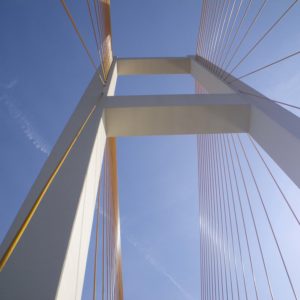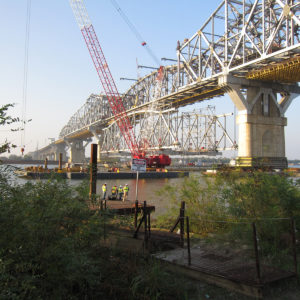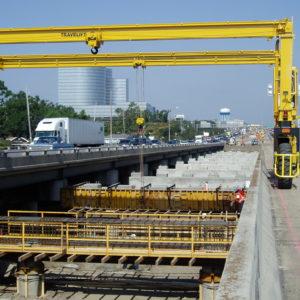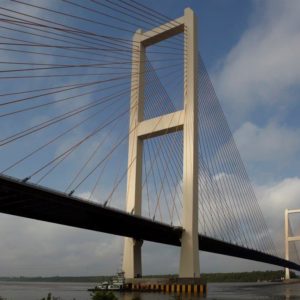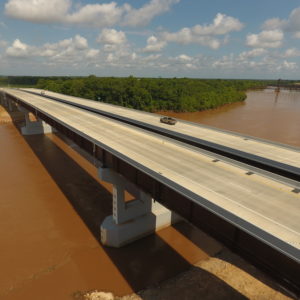GEC’s staff of structural engineers was responsible for the design of all structural components of the Louisa Bridge. The Louisa Bridge is Louisiana’s longest steel girder double-leaf bascule bridge and spans the Intracoastal Waterway in a remote area of St. Mary Parish.
The main navigational span is a semi-high-level, two steel-girder, double-leaf, fixed-trunnion bascule bridge. The longitudinal bridge, with a trunnion-to trunnion distance of 275.6 feet and a width of 40 feet, is one of the longest spans of its type in the United States. In the closed position, it provides a minimum vertical clearance of 73 feet and a horizontal navigation clearance of 200 feet. The superstructure design for both the bascule and adjacent approach spans uses two shallow depth parabolic-shaped welded steel plate girders for each span. These girders were selected for their efficient use of steel, light weight, durability, cost effectiveness, and aesthetic characteristics. The bascule girder tail end utilizes a unique short and compact style counterweight. Special, innovative steel counterweights were efficiently positioned in this tail end in order to minimize the overall counterweight size for aesthetic purposes. In the fully closed position, the bascule tail end seamlessly disappears within the adjacent approach spans, resulting in a pleasing three-span haunched girder-shaped superstructure. In the fully open position, the tail end disappears within the open type bascule pier. The very long and narrow bascule leaves required the floor system to be as light as possible. The floor system design, using steel stringers and steel floor beams supporting a light-weight open steel grating for the roadway deck, was selected for its efficient use of steel. The Louisa Bridge’s shallow-depth parabolic bascule girders vary in depth from 7.5 feet to 17.3 feet and are spaced at 27.6 ft. The two adjoining steel girder spans vary in depth from 8.3 feet to 16.4 feet and are spaced at 33.5 feet. Each leaf of the bascule is driven using curved racks mounted on each girder. The 73-ft. vertical clearance means that the bridge will open infrequently. Therefore, a very basic drive system is used in each leaf, in which a single enclosed gear drive is driven by two 25-horsepower two-speed alternating current motors. The thirty-eight approach spans of five AASHTO BT-72 pre-stressed concrete girders, each stretching 121.4 feet (37 meters), carry the 37.4 foot (11.4 meter) cast-in-place roadway deck to the high-level bascule. Eighteen two-column bents with doubly tapered columns achieve an ultimate deck elevation of over 90 feet (27.4 meters), supported by deep pile footings. Eighteen pile bents, each formed from five 30 inch (750 mm) square piles, support the lower spans. A pile-supported approach slab at each end of the bridge helps transition to the roadway in difficult soil conditions. An Optimization Study was the basis for span lengths and foundation selection.
